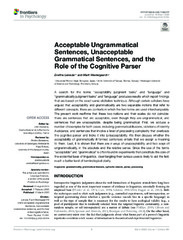Acceptable Ungrammatical Sentences, Unacceptable Grammatical Sentences, and the Role of the Cognitive Parser
Permanent lenke
https://hdl.handle.net/10037/18503Dato
2020-03-10Type
Journal articleTidsskriftartikkel
Peer reviewed
Sammendrag
A search for the terms “acceptability judgment tasks” and “language” and “grammaticality judgment tasks” and “language” produces results which report findings that are based on the exact same elicitation technique. Although certain scholars have argued that acceptability and grammaticality are two separable notions that refer to different concepts, there are contexts in which the two terms are used interchangeably. The present work reaffirms that these two notions and their scales do not coincide: there are sentences that are acceptable, even though they are ungrammatical, and sentences that are unacceptable, despite being grammatical. First, we adduce a number of examples for both cases, including grammatical illusions, violations of Identity Avoidance, and sentences that involve a level of processing complexity that overloads the cognitive parser and tricks it into (un)acceptability. We then discuss whether the acceptability of grammatically ill-formed sentences entails that we assign a meaning to them. Last, it is shown that there are n ways of unacceptability, and two ways of ungrammaticality, in the absolute and the relative sense. Since the use of the terms “acceptable” and “grammatical” is often found in experiments that constitute the core of the evidential base of linguistics, disentangling their various uses is likely to aid the field reach a better level of terminological clarity.
Forlag
Frontiers MediaSitering
Leivada E, Westergaard M. Acceptable Ungrammatical Sentences, Unacceptable Grammatical Sentences, and the Role of the Cognitive Parser. Frontiers in Psychology. 2020;11Metadata
Vis full innførselSamlinger
Copyright 2020 The Author(s)


 English
English norsk
norsk